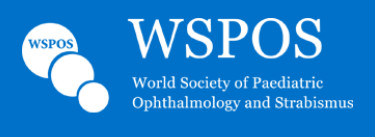Education
Case Report: Case 12
Case Presenters
Professor Alki Liasis PhD, is a consultant clinical scientist in visual electrophysiology. He started his career at the National Hospital for Neurology and Neurosurgery. His background is in medical biophysics, neurophysiology as well as visual electrophysiology. He has undertaking an extensive programme of research through his career investigating the normal visual function and consequences of neurological pathology on the visual pathways in childhood. Countless publications have come from this work and had a direct impact on the management of these children. After 20 years at the Tony Kriss visual electrophysiology unit at Great Ormond Street Hospital for Children London, he recently took up a chair at Children’s Hospital Pittsburgh as a Professor of visual electrophysiology.
Ms. Sian E Handley B. Med Sci. (hons) Orth, MSc, qualified as an Orthoptist at the University of Sheffield, before gaining her MSc in Ophthalmology from University College London. Whilst working at Great Ormond Street Hospital for children London, in addition to her skills as an orthoptist she has developed experience in visual electrophysiology and imaging in the diagnostics of children with complex pathology. Whilst working in clinical practice she also undertakes research with several peer reviewed publications and holds an honorary research assistant position at the Institute of Child Health UCL.
Status: CASE CLOSED
Members’ Responses:
1) Of all the investigations undertaken which did you find the most useful?
7.14% replied Clinical examination, 64.29% said Retinal imaging (colour photos OCT and Autofluoresence), 10.71% replied Pattern Visual Evoked Potentials, 7.14% said Pattern Electroretinogram, 0.00% replied Flash Electroretinogram & 10.71% felt Ultrasound would be most useful.
2) Would you request any additional investigation, if so what would be your priority?
39.29% replied saying they would recommend Fluorescein angiography, 28.57% would recommend Blood tests (ANA, ESR, U&E, FBC, ANCA, toxoplasma screen and complement function), 21.43% opted for MRI & 10.71% would recommend no further investigations.
3) Would you offer any treatment?
10.71% chose Intravitreal injection of bevacizumab, 3.57% would give Intravitreal injection of ranibizumab, 7.14% opted for Intravitreal injection of a steroid & the remaining 78.57% would do Nothing – observe
Experts Opinion
Subhadra Jalali
Dr. Subhadra Jalali, did her MBBS from govt. Medical College Jammu in 1986 and MS from PGIMER, in 1989. She completed two-year fellowship from LVPEI in 1993, and further fellowships in USA in Ocular genetic diseases, Electrophysiology of vision and Posterior Uveitis (1995) and in Retinopathy of Prematurity and Paediatric retinal disorders (1998). Presently she is working as a Consultant at the LVPEI since 1993 and running a very successful exclusive Paediatric retina service. She was amongst the first group of pioneering women in India to go for exclusive Retinal surgery practice that was an exclusive male domain at that time. She has over 550 presentations including orations and 155 publications in National and International journals and 15 book chapters. She is a Co-investigator in various multicentric international studies. She is the recipient of State, National and International awards including the AAO and APAO Achievement awards, ISCEV travel grant, P. Siva Reddy award to name a few.
Her crowning glory is however the more than 350 fellows trained by her in ROP from Mexico to Azerbaijan to Indonesia and Bangladesh besides all over India through one of the first dedicated one month hands-on ROP training program. The IJO platinum award is for her pioneering work published on outcomes of
setting up a city-wide ROP program, the first one in India and in most of the countries. She is now working for setting up similar programs in cities and towns of India and also in neighbouring countries. She loves dancing and enjoying various cultures around the world.
1) Of all the investigations undertaken which did you find the most useful?
Each has its own importance and I would not pick one more than other. Clinical examination provided the possible causes and extent of anticipated dysfunction. Structural tests (b, f) complimented functional tests (c, d, e). Presence of drusen in optic N head provided a possible etiology to the peripapillary scar from healed CNVM that were well delineated by fundus photo and OCT. Patterm VEP and Pattern ERG very well demonstrated that the macular pathology is main cause of reduced vision and not to an additional optic N condition. I wish the B scan USG image was also provided to understand how was the ‘very small linear drusen’
2) Would you request any additional investigation, if so what would be your priority?
No, I would make a diagnosis of Optic N head drusen with a healed peripapillary neovascular membrane that is now scarred. I would not do any further testing unless on follow up, if RAPD increases or more disc pallor sets in. However, since the USG image is not provided, I would like to see that to confirm my statement. (Ref: Optic disc drusen and peripapillary subretinal neovascular membranes in children: Wilson, Graham A, Lloyd, Chris, Moore, Anthony T, Journal of Pediatric Ophthalmology and Strabismus; Nov/Dec 2002; 39, 6; ProQuest Central pg. 351)
3) Would you offer any treatment?
Nothing, Observe only.
4) What is your differential diagnosis?
a. Optic disc drusen with peripaillary scarred srnvm.
b. Healed Toxo with healed scarred secondary CNVM: unlikely due to extensive lesion and subretinal gliosis
5) The child is consistently adamant her vision in the left eye is no perception of light. Do you agree?
How would you try to prove / disprove this?
The initial Optometerist had referred with hand movements vision. It is possible that she is tired of repeated testing and so mentioning no PL so as to avoid further testing. It is unlikely to be no PL because of VEP resposes and also RAPD is mentioned as mild. I would not make too much effort for proving PL present in the eye. As child has provided decent recordings of pattern ERG and pattern VEP testing uniocularly, she should have vision of PL or more. This is so, because to get a good reliable recording, child has to fixate at the monitor light or pattern and a no PL eye is unlikely to get that. To me, presence of PL is already proved.
Marco Pellegrini
Dr. Marco Pellegrini graduated in 2007 and completed his residency program in ophthalmology in 2012 at the University of Milan. In 2013 he concluded is fellowship program at the ocular oncology department of Wills Eye Hospital in Philadelphia under the guidance of Dr. Jerry and Carol Shields.
Dr. Pellegrini currently works as a retina specialist at the Eye Clinic of “Luigi Sacco Hospital” in Milan directed by prof Giovanni Staurenghi where he is also the director of the ocular oncology service. He is currently a member of the main ocular oncology and retina societies and serves as a reviewer for the major international scientific journals. Dr. Pellegrini has been a speaker for several national and international conferences and has written as author/coauthor scientific papers published in peerreviewed journals.
1) Of all the investigations undertaken which did you find the most useful?
Retinal imaging was the most useful examination in order to characterize the retinal alterations. In particular, it displayed a well demarcated circumpapillary chorioretinal lesion with pigmented margins and an overlying type II choroidal neovascularization complicated by intraretinal fluid. Additionally, signs of chronicity could be recognized including outer retinal tubulations and outer retinal structures disruption.
2) Would you request any additional investigation, if so what would be your priority?
I personally would advise to perform both wide field fluorescein and indocyanine green angiography for evidencing possible signs of retinal inflammation or non-perfusion and to exclude deep structures involvement (choriocapillaris ischemia or choroidal granulomas). Furthermore, a detailed exam of the right eye should be conducted. According to imaging results blood tests may be planned.
3) Would you offer any treatment?
In consideration of the low residual visual acuity and OCT features, I would not perform local treatment.
4) What is your differential diagnosis?
Among differential I would first rule out causes of inflammatory/infective CNV and serpiginous-like forms. In particular, as regard secondary CNV, I would rule out intraocular tubercolosis, syphilis, sarcoidosis and, lastly, an idiopathic form.
5) The child is consistently adamant her vision in the left eye is no perception of light. Do you agree? How would you try to prove / disprove this?
According to the imaging test performed, I would expect a better visual acuity. Study of pupillary reflexes and visual evoked potentials may be used to confirm it.
Marcia Tartarella
Dr. Marcia Tartarella Graduated in Medicine from the Federal University of São Paulo (UNIFESP) in 1985. She then went on to do a Medical Residency Program with a Specialization in Ophthalmology at UNIFESP between 1986 and 1989. Dr. Tartarella then acquired her Masters and PhD in Medicine (Ophthalmology) from the UNIFESP in 1994 & 1999 respectively. Her fields of interest include Congenital Cataract, Prevention of Blindness and Corneal Transplants. She received the Varilux Prize for Ophthalmology from the Brazilian Society of Ophthalmology (SBO), one of the most important Brazilian awards in the medical field, in the year 2000.
1) Of all the investigations undertaken which did you find the most useful?
Retinal imaging is very important to understand the anatomical damage to the eye. OCT obtained photo documentation of the structural changes of the retinal lawyers. But all other investigations are necessary to understand the case and to obtain the best option of treatment. Electrophysiological tests are useful to analyse the functional status of the eye. In this case, VEP showed macular responses. Clinical examination is mandatory. Family history could determine a genetic condition, as the father declared to have amblyopia. Ultrasound did not add much to this case, but US was also necessary to rule out optic nerve and the retinal anomalies.
2) Would you request any additional investigation, if so what would be your priority?
Fluorescein angiography helps to analyse the status of the retina and macular involvement. The study of retinal cystic edema and secondary choroidal neovascular membrane could lead to a better decision of treatment. Blood tests are also necessary in order to disclose the aetiology. Infectious diseases should be investigated according to the environment of the child. Among children of Latin America, Tuberculosis has to be ruled out. Histoplasmosis tests might also be performed. This retinal lesion is not typical of toxoplasmosis, but it should also be considered and screened.
3) Would you offer any treatment?
Anti VEGF should be administered if there is light perception in the LE with the chance of visual improvement following therapy. Some published studies show that anti-VEGF agents were effective in the treatment of choroidal neovascular membranes in children, with no side effects observed. If no light perception is considered or confirmed, then no invasive procedure should be performed. And only observation will be necessary.
4) What is your differential diagnosis?
a. Peripapillary choroidal neovascular membrane (PCNM)
b. Previous Ocular trauma – Traumatic choroidal rupture (children may be afraid to tell about trauma to their parents)
c. Angioid streaks (one case reported in a 12 years old child)
d. Serpiginous Choroiditis
e. Systemic disease or infection (Histoplasmosis / Sarcoidosis) with secondary neovascular subretinal membrane
f. Optic Nerve Malformation (Morning Glory disc syndrome: one case reported, and one case with follow up in our Pediatric Ophthalmology Ambulatory)
5) The child is consistently adamant her vision in the left eye is no perception of light. Do you agree?
How would you try to prove / disprove this? According to the electrophysiological tests, LE should have light or movements perception. They could re-test visual acuity using a high plus lenses in the RE, and performing the visual tests with both eyes at the same time. Or they could use a prism in the right eye to try to obtain a response of double vision to confirm vision in the LE.

